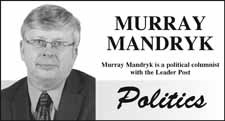As Telemiracle rolls around each year, we are reminded of the generosity of rural Saskatchewan's savers.
The Kinsmen's fabulously successful annual fundraiser has become more successful in recent years because of large donors bequeathing hundreds of thousand dollars to the charity fundraiser.
Almost invariably, they are old farmers or others from rural Saskatchewan who lived frugally all their lives and viewed the charitable foundation as the best way to give back to future generations after they were gone.
These people have been the backbone of this province and thoughts of them crosses one's mind as Saskatchewan embarks on what might be its biggest savings project in our history.
The Saskatchewan Futures Fund was unveiled last week. Its author, former University of Saskatchewan President Peter MacKinnon, described it as a "permanent intergenerational savings and investment fund" that could convert "excess" one-time non-renewable natural resource money into support for future generations.
Conceptually, there is actually little new in what MacKinnon is proposing. Alberta has had a similar Heritage Fund setting aside some of its present-day natural resource wealth for future generations. So has Norway, from where MacKinnon got many of his ideas.
MacKinnon's proposal would set aside no more than 26 per cent of the provinces "excess" natural resource revenue - based on the average of the previous five years - in any given year.
If natural resources that year did not exceed the five-year average, there would obviously be no money set aside. However, if we averaged $3 billion a year over the previous five years and pulled down $4 billion on one particularly good year when oil, potash, natural gas, gold, uranium, were all doing well, we would have a tidy $780 million for the Futures Fund that year and the government would still have an extra $220 million to play with.
In fact, MacKinnon estimated that had we started this particular fund in 2003-04, we would have already had $12 million stashed away by the end of this fiscal year in March. (However, it is worth noting that 2003-04 was actually the start of the Saskatchewan boom that saw the current rapid rise in resource revenue.)
MacKinnon further suggests the fund could be used to pay down provincial debt - the lasting legacy of the Grant Devine government. The fund could also be supplemented with stocks and bond investments.
It all sounds rather good, but you might be wondering what all this has to do with the generation of rural Saskatchewan savers that have so generously donated to Telemiracle.
Well, it might actually speak to why such a modern day Future funds will be harder to implement than it seems.
Many of those rural people donating so generously to things like Telemiracle were weaned on the Great Depression, growing up knowing no other way than to get buy with less.
This trait is less common in each generation, as people demand more and more for themselves and from the government. This is also reflected in why we really haven't saved all that much in this time of plenty when Saskatchewan's public debt has actually increased.
Yes, our revenues have increased at a fantastic 77 per cent since that 2003-04 budget. But our spending has increased 87 per cent. What should have been massive surplus budgets have really only been modest surpluses or sometimes even overall deficits.
Unlike the Saskatchewan of the past, people are dissatisfied with getting by with less. Larger and larger wage demands from public servants, more government programs and demands for less taxation keep coming from people feeling increasingly more entitled to spend our one-time resource revenue.
And unless we have more "savers" that there appears to be, this Futures Fund might be tougher to fill than some think.
Murray Mandryk has been covering provincial politics for over 22 years.




